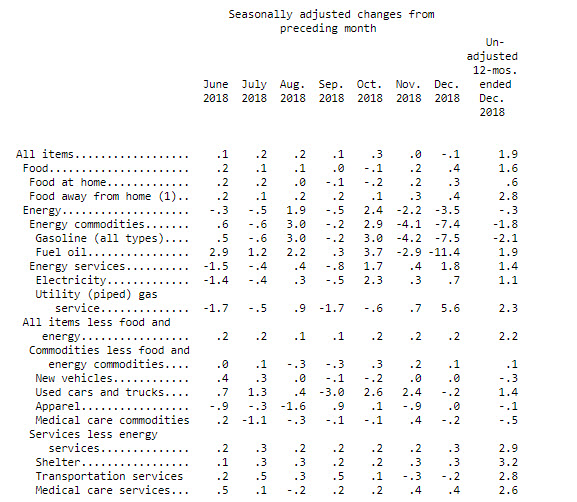The Consumer Price Index for All Urban Consumers (CPI-U) declined 0.1 percent in December on a seasonally adjusted basis after being unchanged in November, the U.S. Bureau of Labor Statistics reported today. Over the last 12 months, the all items index increased 1.9 percent before seasonal adjustment. The seasonally adjusted decline in the all items index was caused by a sharp decrease in the gasoline index, which fell 7.5 percent in December. This decline more than offset increases in several indexes including shelter, food, and other energy components. The energy index fell 3.5 percent, as the gasoline and fuel oil indexes fell, but the indexes for natural gas and for electricity increased. The food index increased 0.4 percent in December. The index for all items less food and energy increased 0.2 percent in December, the same increase as in October and November. Along with the index for shelter, the indexes for recreation, medical care, and household furnishings and operations all increased in December, while the indexes for airline fares, used cars and trucks, and motor vehicle insurance all declined. The all items index increased 1.9 percent for the 12 months ending December; this was the first time the 12-month change has been under 2.0 percent since August 2017. The index for all items less food and energy rose 2.2 percent over the last 12 months, the same increase as for the 12 months ending November. The food index rose 1.6 percent over the past year, while the energy index declined 0.3 percent.
Food The food index rose 0.4 percent in December, the largest increase since May 2014. The food at home index rose 0.3 percent, as the index for fruits and vegetables increased 1.7 percent. The index for fresh fruits rose 1.3 percent and the fresh vegetables index increased 2.6 percent. The index for cereals and bakery products advanced 0.4 percent, and the indexes for dairy and related products and for nonalcoholic beverages both increased 0.3 percent. The index for meats, poultry, fish, and eggs was unchanged, while the only major grocery store food group index to decline was other food at home, which fell 0.3 percent. The index for food away from home rose 0.4 percent, with the indexes for both full service meals and limited service meals increasing. The index for food at home rose 0.6 percent over the past year, with four of the six major grocery store food groups increasing over the span. The food away from home index increased 2.8 percent over the past 12 months. Energy The energy index fell 3.5 percent in December following a 2.2-percent decline in November. The gasoline index fell 7.5 percent in December after a 4.2-percent decline the prior month. (Before seasonal adjustment, gasoline prices fell 9.9 percent in December.) The fuel oil index also declined sharply in December, falling 11.4 percent. However, the other major energy component indexes rose in December, with the index for natural gas increasing 5.6 percent and the electricity index rising 0.7 percent. The energy index fell 0.3 percent over the past 12 months; this represented the first 12-month decline in the energy index since the period ending September 2016. The gasoline index declined 2.1 percent over the last year, more than offsetting increases in the other component indexes. The electricity index rose 1.1 percent, the index for natural gas increased 2.3 percent, and the fuel oil index advanced 1.9 percent. All items less food and energy The index for all items less food and energy increased 0.2 percent in December. The shelter index increased 0.3 percent in December, the same increase as the prior month. The indexes for rent and owners' equivalent rent both increased 0.2 percent, while the index for lodging away from home rose 2.7 percent. The recreation index rose in December, increasing 0.6 percent. The medical care index rose 0.3 percent in December with its major component indexes mixed. The index for hospital services rose 0.5 percent, the physicians' services index was unchanged, and the index for prescription drugs declined 0.4 percent. The index for household furnishings and operations rose 0.3 percent in December, and the education index rose 0.2 percent. The index for airline fares fell 1.5 percent in December following a 2.4-percent decline in November. The index for used cars and trucks fell 0.2 percent after rising in October and November. The motor vehicle insurance index fell 0.2 percent, its second consecutive decline. Several indexes were unchanged in December, including those for new vehicles, apparel, and communication. The index for all items less food and energy rose 2.2 percent over the past 12 months, the same increase for the period ending November. The shelter index increased 3.2 percent over the last year, and the medical care index rose 2.0 percent. Not seasonally adjusted CPI measures The Consumer Price Index for All Urban Consumers (CPI-U) increased 1.9 percent over the last 12 months to an index level of 251.233 (1982-84=100). For the month, the index decreased 0.3 percent prior to seasonal adjustment. The Consumer Price Index for Urban Wage Earners and Clerical Workers (CPI-W) increased 1.8 percent over the last 12 months to an index level of 244.786 (1982-84=100). For the month, the index decreased 0.5 percent prior to seasonal adjustment. The Chained Consumer Price Index for All Urban Consumers (C-CPI-U) increased 1.8 percent over the last 12 months. For the month, the index declined 0.3 percent on a not seasonally adjusted basis. Please note that the indexes for the past 10 to 12 months are subject to revision. Year in Review (December to December) The all items CPI rose 1.9 percent in 2018, a smaller increase than the 2.1 percent increase in 2016 and 2017, but larger than the increases in any of the years from 2012 to 2015. It was also slightly larger than the 1.8-percent average annual increase over the past 10 years. The food index increased 1.6 percent in 2018, the same increase as in 2017. The index for food at home increased 0.6 percent in 2018 following a 0.9-percent increase in 2017. Four of the six major grocery store food group indexes increased in 2018. The index for cereals and bakery products increased the most, rising 1.7 percent after declining in 2016 and 2017. The fruits and vegetables index, which rose 1.5 percent in 2017, increased 1.6 percent in 2018. The index for nonalcoholic beverages increased 1.4 percent in 2018 after being unchanged in 2017. The index for other food at home also increased in 2018, rising 0.2 percent after advancing 0.5 percent the prior year. In contrast, the index for meats, poultry, fish, and eggs declined in 2018, falling 0.4 percent after rising 2.8 percent in 2017. The dairy and related products index fell slightly in 2018, decreasing 0.1 percent, the fourth yearly decline in a row. The index for food away from home rose 2.8 percent in 2018 after a 2.5-percent increase the prior year. Over the last 10 years, the food index rose at an average annual rate of 1.6 percent. The food at home index rose at a 0.9-percent rate, and the index for food away from home increased at a 2.4-percent rate since December 2008. The energy index fell slightly in 2018, declining 0.3 percent after rising 6.9 percent in 2017. The gasoline index fell 2.1 percent in 2018 after rising in 2016 and 2017. The decline in the gasoline index more than offset increases in other energy component indexes. The index for electricity increased 1.1 percent in 2018 after rising 2.6 percent the prior year. The index for natural gas rose for the third consecutive year, increasing 2.3 percent. The fuel oil index rose 1.9 percent in 2018. The energy index increased at a 1.9-percent average annual rate over the past 10 years. The index for all items less food and energy rose 2.2 percent in 2018, a larger increase than its 1.8-percent rise in 2017 and 1.8-percent average annual increase over the past 10 years. The shelter index rose 3.2 percent in 2018, the same increase as in 2017. The rent index rose 3.5 percent in 2018, while the index for owners' equivalent rent increased 3.2 percent. The index for household furnishings and operations increased 2.1 percent after falling in each of the prior 5 years. The medical care index rose 2.0 percent in 2018, a slightly larger increase than its 1.8-percent increase the prior year. The index for hospital services rose 3.7 percent, while the physicians' services index increased 0.6 percent. The index for prescription drugs, however, fell 0.6 percent in 2018. The index for motor vehicle insurance rose 4.6 percent in 2018 following larger increases in recent years. The index for new vehicles fell for the second year in a row, decreasing 0.3 percent after a 0.5-percent decline in 2017. The index for used cars and trucks rose 1.4 percent in 2018 after decreasing in each of the prior 2 years. The education index increased 2.6 percent in 2018 after a 2.0-percent rise in 2017. The index for communication declined 1.8 percent in 2018, its ninth consecutive yearly decline. The recreation index rose 1.2 percent, and the index for personal care increased 1.8 percent. The index for tobacco increased 3.4 percent, and the alcoholic beverages index rose 1.8 percent. The index for airline fares decreased for the sixth year in a row in 2018, falling 2.6 percent. The apparel index declined for the fifth consecutive year, though it decreased only 0.1 percent in 2018.
Content is for general information purposes only. It is not investment advice or a solution to buy or sell securities. Opinions are the authors; not necessarily that of OANDA Business Information & Services, Inc. or any of its affiliates, subsidiaries, officers or directors. If you would like to reproduce or redistribute any of the content found on MarketPulse, an award winning forex, commodities and global indices analysis and news site service produced by OANDA Business Information & Services, Inc., please access the RSS feed or contact us at info@marketpulse.com. Visit https://www.marketpulse.com/ to find out more about the beat of the global markets. © 2023 OANDA Business Information & Services Inc.




